Email Question
Dear Gail, I loved your new video on exercises for optimal fetal positioning! I finally got my second baby into the right position but alas, he did not engage and I did not go into labour which resulted in an elective section at 42 weeks. I had a previous cesarean when my waters broke without contractions. My first baby didn’t engage despite being induced. I’m now wondering if there is something wrong with my hips? Do you have any idea on why neither of my babies engaged?
Please note: Slight editorial changes were made here to help you understand the email better.

This baby is well engaged and fitting through the inlet and midpelvis.

Lack of engagement in the pelvic brim (inlet). One parietal eminence remains outside the pelvic brim.
Baby stays high, -3 Station or higher.
From Smellie.
Gail’s Response
Congratulations on new motherhood again. Congratulations on your new baby! I’m so impressed with how much you did to achieve a natural birth and try to wait for labor. I may be able to shed some light on the mystery or, I may not…let’s try.
When baby is in an optimal position and doesn’t engage I wonder about
- Misalignment of the pelvis (SI and symphysis joints, rotation of sacrum on vertical axis)
- A reduced diameter of the pelvic inlet from nutritional or sunlight deficiencies growing up
- Psoas tightness (see www.coreawareness.com)
- Scoliosis
- Something to do with the baby and cord: short or wrapped cord, or baby’s arm in the way
- Dates are incorrect and baby is 2-4 weeks early
- An overall small pelvis. When an ideally positioned baby, Flexed and Left Occiput Anterior or Left Occiput Transverse doesn’t fit the bones, then we have a true Cephalo Pelvic Disporportion, or CPD, which means baby’s head really is too big for the pelvis.
To guide our train of thought, I want to acknowledge that you’ve had two babies that did not engage. That makes the question of correct dates, a short or wrapped cord, or compound presentation (hand or arm coming with the head) unlikely.
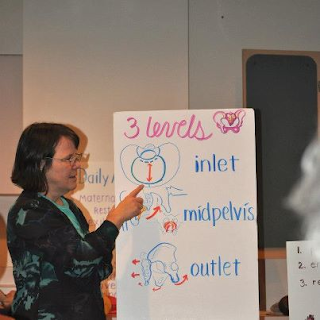
Did either baby have any molding on the head? Molding would typically only be seen after many hours of very strong and frequent uterine contractions. Actually, many babies that haven’t engaged even with strong, frequent contractions show no molding of the head. But its a clue that may help if it is present.
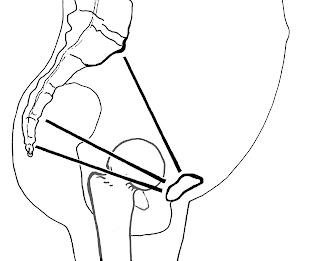 The lines represent (from the top) the pelvic inlet, the midpelvis, and the outlet diameters.
The lines represent (from the top) the pelvic inlet, the midpelvis, and the outlet diameters.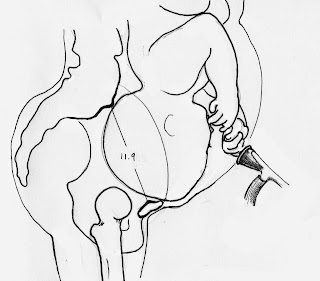 A posterior baby remains on the pubic bone and not engaged.
A posterior baby remains on the pubic bone and not engaged.Let’s talk about three places in the pelvis for a self-check.
- The sitz bones
- The pubic arch
- The front to back distance between bones (not the padding around the bones, so to speak)
- The side to side distance between hip bones.
Remember, Measurements can’t usually tell you if you can fit a baby through the pelvis. Once the baby is engaged, then the size of the pelvis becomes less important than the mobility of the pelvis!!
1. ) The Sitz bones, or Ischial Tuberosities, make up the side limits of the outlet.

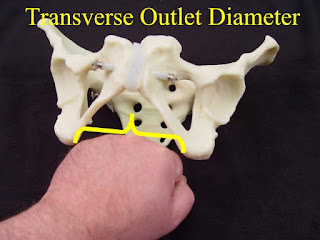 Image from https://library.jefferson.edu/Collections/DVDs/obgyn101/Text/Abnormal%20L&D/fetopelvic_disproportion.htm
Image from https://library.jefferson.edu/Collections/DVDs/obgyn101/Text/Abnormal%20L&D/fetopelvic_disproportion.htmYou can lay on your side and use your own fist from behind you. Or, ask your mate.
Find your top sitz bone beneath the padding of the upper buttocks.
Feel for the edge of the lower sitz bones, its a bit of a reach.
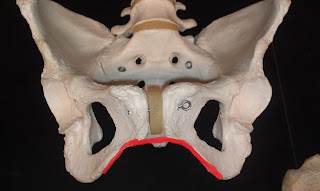
Pubic arch in red
Laying on your back with knees bent, wrap your fingers around your pubic arch. It’s like a kid grabbing themselves to avoid peeing their pants. You don’t have to smash your fingers into your urethra, be kind. The measuring place is between the top and the sitz bones at the bottom of the pubic arch.
B. Or is the arch very wide, even four of your own fingers fit across?
An alternate way of assessing if one has a Platypelloid Pelvis
4.) Approximate distance between hips
Stand and measure the distance from hip to hip (ASIS). Use a tape measure or ruler.
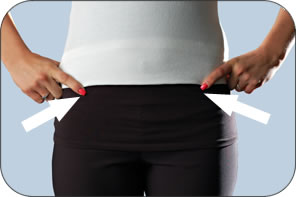
Image from https://www.activeortho.com/store/how_to_measure_si_belt.html
I also like the Serola Sacroiliac belt https://www.serola.net/serola-sacroiliac-belt
Your hip to hip bone measurement is
A. 11-13 inches
B. 15-17 inches between boney hips.
The fourth measurement verifies the 3rd.
Outcomes of Your Pelvimetry
In that case, you find close tuberosities (Sitz bones) and a very narrow pubic arch of only 1.5 or maybe 2 fingers across.
Not engaging from a posterior position is common for this pelvic shape. Helping baby be in an ideal LOA position usually brings about engagement and labor progress. It is not uncommon for birth providers not to know how to help engage baby in an android pelvis. Walking the halls is unlikely to engage or rotate a posterior baby in this pelvis.

Another possibility to lack of engagement is a narrow front-to-back pelvic diameter, called the Platypelloid pelvis, which can make engagement an agony when baby starts posterior. Helping this baby into a Left Occiput Transverse position is the only way for baby to engage. That will immediately relieve the brim pain and labor will likely stop so the uterus can rest and then after a meal, labor will resume and bring the baby in 6-8 hours. If the uterus doesn’t need a rest (maybe because baby started LOT then labor may be 24 hours or less in this pelvis, a second baby may come in 6-8 hours total if starting LOT.)
When pelvic shape is the issue, we see that skills in supporting a labor with a pelvis that is not round is of key importance. Skills to support labor are slipping away from the world. Spinning Babies is determined to bring them back!
“This is amazing! Thank you Gail!!
I’m so thankful for your response as the midwives and doctors I have asked have not been helpful.
Yes, you can absolutely use my question in your blog. My first baby was [Occiput Posterior] which is why I believe the waters broke early – well it was actually on my due date but I always presumed he just wasn’t ready to come but if it is a case of there being something wrong with my hips then it could be that he just couldn’t engage…
My mother was told she had “tilted hips” which resulted in 3 c-sections for here so perhaps there is hereditary here!
I had been preparing for a VBAC for over a year! I never thought I’d end up with an elective but just bring supported by the hospital staff to go right up to 40+16 was healing for me, I felt like I gave it my best shot but I am just so curious as to why I didn’t go into labour!… “
